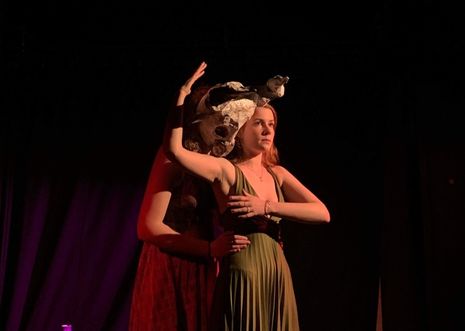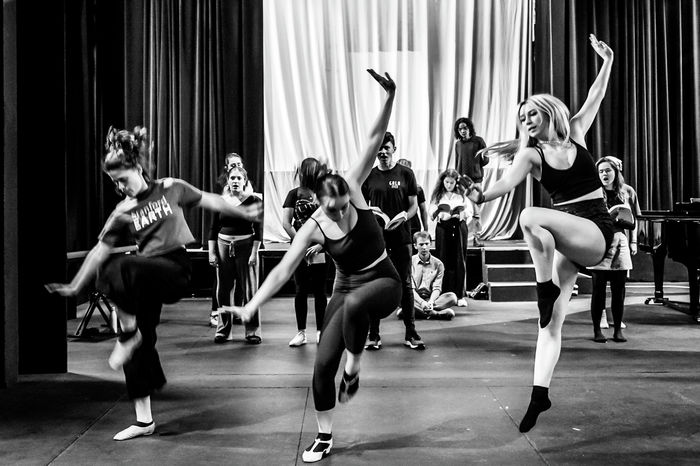Pasiphae: Mother of the Minotaur is a feast for the senses
A transformative and intensely emotional piece of new writing based on threads of Euripides’ The Cretans

Pasiphae: Mother of the Minotaur takes the threads of Euripides’ lost play The Cretans, cradles them tenderly, and weaves them into a multisensory tapestry of dance, puppetry and lyricised lust. Pasiphae is cursed by Poseidon with maddening desire for the bull her husband neglected to sacrifice – he, too, was awestruck by its beauty, killing another in its place. But this production doesn’t demonise her “malady of the mind.” Evie Chandler’s new play positions itself as a “feminist imagining” of the original drama, unfurling from its heroine’s consciousness. It beautifies her lust as it exposes the true brutality of the reality her curse effaces, such as an Ariadne who is “my king’s daughter first, your daughter last.” Unwinding itself from Euripides’ surviving fragments, it presents a Pasiphae embroiled in madness and mythologised dreamscape, drawing along with her a fierce undercurrent of matriarchal violence and fury.
The play opens with our titular Queen curled up in the centre of the floor, dreaming atop a singular sheet of white cloth. Three figures whirl around her in eddies and flowing robe-like dresses. They draw in above her, muttering incantations to muses and poets that entangle the fabric of the play with an ancient mythological tradition. It becomes clear that these figures comprise both the Chorus and, ominously, the Fates. This combination twists the homogenised, commentative group of voices that traditionally makes up a Greek Chorus to its own ends. Three voices are dissected to speak individually in accordance with this group of mythological sisters, taking an active role in Pasiphae’s life as they hold its thread in their hands. Chandler’s slick incorporation of this Chorus enables a constant slippage between narrative modes. The three actors multirole, but dip in and out of direct audience narration, so that even the script is in constant transformation.
“Transformation is integral to the play”
And transformation is integral to the play – Pasiphae yearns to become like her beloved beast, citing Europa and Io as she laments. The costumes of the Chorus exacerbate a tentative sense of layered metamorphosis. Changes in character are signalled by almost synecdochic items of clothing or prop atop their white base – Ariadne is enclosed in a red ribbon tied around her waist, and the minotaur is manifested through mask alone. This semi-transparent layering leaves the Fates’ costumes always visible underneath, an ever-present visual recognition of Pasiphae’s controlled destiny. The Chorus stand in the gloomy corners of the darkly lit stage, serving as periodic reminders of a space manipulated and framed by fate, robed figures which watch both stage and audience.
This play is overwhelmingly physical, and the opening sets a precedent for strikingly precise and symbolic movement. The Chorus lean in graduated positions over Pasiphae’s dreaming body, extending arms and hands to pluck her life thread in synchrony with Stan Hunt’s compositions. This movement imitates a kind of puppetry which preempts Amy Brian’s later designs. Alix Addinall’s choreography is indicative of this production’s elegant craftsmanship; a show with intricately intertwined mediums. Its early scenes, which enmesh light, sound, dance and puppetry, project Pasiphae’s maddened mind upon the backdrop of a barren black stage. As her dreams are made manifest, floods of blue light (Poseidon’s presence) rapidly overwhelm the previously white-lit space. The Minotaur walks in through the open on-stage door, looming with thudding steps behind an unseeing Minos.
“The distinction between dream and reality becomes impossible to discern”
The flow from this dream into Pasiphae’s interaction with the Cretan Bull (the action dips only momentarily from the dream-like) casts the following scene in an intoxicatingly feverish light. This is both figurative and literal – scattered upon the stage was a green wash pierced with shapes of light and shadow, like sun through tangled leaves. The distinction between dream and reality becomes impossible to discern. Each moment is a near-ekphrastic representation of a myth already figured in mediums across millenia. As Pasiphae reaches out to not-quite-touch the bull – a dismembered, dissected puppet animated by the puff of the Chorus’ breath – her hand hovers in the light. She echoes a motif of reaching out to the divine; one that situates itself simultaneously in the central diagonal corners of the Playroom and the lights that beam there.
It is this stylised embracing of the space's weirdness that renders Pasiphae breathtakingly artistic. Facing diagonally across the stage to the wall rupturing the two sides of the audience, the cast is repeatedly composed into tableaus stilled and framed by bright washes of light. When these are frozen into vivid colour, the background of the stage is lost into an absorbing, total blackness. The composition of actors is akin to figures upon a Grecian red-figure vase. Pasiphae crafts a visual (and lyrical) poeticism which sits in oppositional balance with the grotesque obscenity of its subject, bringing not just bloodiness and bestiality but restoring the magic which this daughter of Helios is so often denied.
 News / SU stops offering student discounts8 January 2026
News / SU stops offering student discounts8 January 2026 News / Uni-linked firms rank among Cambridgeshire’s largest7 January 2026
News / Uni-linked firms rank among Cambridgeshire’s largest7 January 2026 Comment / Plastic pubs: the problem with Cambridge alehouses 5 January 2026
Comment / Plastic pubs: the problem with Cambridge alehouses 5 January 2026 News / New movement ‘Cambridge is Chopped’ launched to fight against hate crime7 January 2026
News / New movement ‘Cambridge is Chopped’ launched to fight against hate crime7 January 2026 Comment / What happened to men at Cambridge?31 December 2025
Comment / What happened to men at Cambridge?31 December 2025









